 Who invented butter-almond crescents, the sugar-dusted confections served at Christmas time in many parts of the world? Some say the cookies were invented by a Viennese baker who adopted the shape of the Ottoman flag’s crescent moon to celebrate victory over the Turks in the 17th century. But I’m not so sure, as crescent almond cookies exist far beyond Vienna. In North Africa, for example, they’re called gazelle horns…
Who invented butter-almond crescents, the sugar-dusted confections served at Christmas time in many parts of the world? Some say the cookies were invented by a Viennese baker who adopted the shape of the Ottoman flag’s crescent moon to celebrate victory over the Turks in the 17th century. But I’m not so sure, as crescent almond cookies exist far beyond Vienna. In North Africa, for example, they’re called gazelle horns…
Biscuits de Noël aux amandes / Butter-almond crescents
Butter-almond crescents are also French, as they are served in Alsace from Advent to Christmas. In the States, they were a specialty of my Jewish mother, and even more so of her mother, Hilda, who had roots in Vienna. Happily they both passed the recipe down to me — I have handwritten copies from each of them — and today I wanted to share it with you. It feels appropriate, at this parlous moment of world history, to mark a holiday that is devoted to peace on earth with a cookie enjoyed by Christians, Muslims and Jews alike.
Butter-almond crescents, known in the German-speaking world as vanillekipferl, are an almond shortbread flavored with vanilla and dusted with confectioner’s sugar, aka powdered sugar, icing sugar or sucre glace. Making them is both easy and fun. Butter, flour, sugar and vanilla are blended together to form a dough. The dough is chilled before being formed into crescent shapes, baked briefly, then dipped into the powdered sugar.
The dough may be formed into other shapes, such as disks topped with a candied cherry or a small bit of candied lemon, orange or lime rind. This makes for a colorful display when you bring the cookies out over the holidays. But beware — once the cookies come out of the oven, it can be hard to keep them around long enough to have any left by Christmas. This happened this year. I made the cookies early to be able to write this post. I had intended to save them all until Christmas Eve, but my daughter had another idea…
The remaining butter-almond cookies have now been stashed in the freezer along with another of my mother’s specialties, bourbon balls. I haven’t posted that recipe yet, but it’s similar to the recipe for chocolate truffles if you’d like to create a mixed plate of pretty sweets. I made the bourbon balls early this year, too, in order to be able to send both kinds of cookies to my brother and sister-in-law in California. Happy holidays, Ben and Mary!
With Christmas only ten days away, this is a good time to check out The Everyday French Chef‘s Holiday Menus, with ideas for festive meals with a French touch for omnivores, vegetarians and vegans. Here’s wishing you a joyous holiday season. And happy cooking!

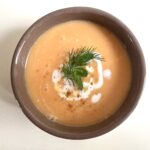 A nice warm bowl of silky-smooth soup of sweet potato and leek with coconut milk, lime juice and spices might be just what the doctor ordered as we head into December. I came up with this one when a glitch in this year’s Thanksgiving plans left me with an abundance of uncooked sweet potatoes. It was a cinch to make — took less than half an hour — and the result was a very soothing soup with Asian flavors that was both healthy and economical.
A nice warm bowl of silky-smooth soup of sweet potato and leek with coconut milk, lime juice and spices might be just what the doctor ordered as we head into December. I came up with this one when a glitch in this year’s Thanksgiving plans left me with an abundance of uncooked sweet potatoes. It was a cinch to make — took less than half an hour — and the result was a very soothing soup with Asian flavors that was both healthy and economical.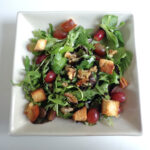 Returning to the sweet potato-leek soup, it may be served at lunchtime, accompanied by sandwiches or a salad, or as a first course for a more elaborate meal. My daughter and I enjoyed it for lunch with
Returning to the sweet potato-leek soup, it may be served at lunchtime, accompanied by sandwiches or a salad, or as a first course for a more elaborate meal. My daughter and I enjoyed it for lunch with  Plov is a rich and spicy rice dish from Central Asia that is traditionally made with lamb, although other meats are sometimes used. The lamb is browned with carrots and onions before being simmered with cumin seeds, paprika and turmeric or saffron. Quince or chickpeas may also be included. A layer of rice studded with whole cloves of garlic is added at the end and steamed to tender perfection to create a festive one-dish meal.
Plov is a rich and spicy rice dish from Central Asia that is traditionally made with lamb, although other meats are sometimes used. The lamb is browned with carrots and onions before being simmered with cumin seeds, paprika and turmeric or saffron. Quince or chickpeas may also be included. A layer of rice studded with whole cloves of garlic is added at the end and steamed to tender perfection to create a festive one-dish meal.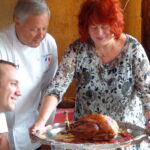 P.S. With Thanksgiving around the corner, here are some recipes that could lend a French touch to the festivities:
P.S. With Thanksgiving around the corner, here are some recipes that could lend a French touch to the festivities: 
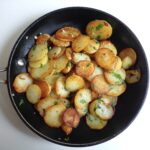 If you’d like to try your hand at rendering duck fat, you could start out with one of these recipes:
If you’d like to try your hand at rendering duck fat, you could start out with one of these recipes: 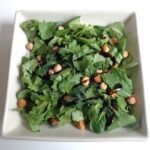 I wanted to make an autumnal salad with hazelnuts and fresh herbs. This, I thought, would be a simple matter. Mais non, mes amis. I made the mistake of starting with hazelnuts still in their peels. Figured it would easy to blanch the nuts and remove the peels. I was wrong. It took me half an hour to rub the peels off just 20 hazelnuts, and the job was imperfect, with stubborn bits clinging on. Then I roasted the nuts, and they burned…
I wanted to make an autumnal salad with hazelnuts and fresh herbs. This, I thought, would be a simple matter. Mais non, mes amis. I made the mistake of starting with hazelnuts still in their peels. Figured it would easy to blanch the nuts and remove the peels. I was wrong. It took me half an hour to rub the peels off just 20 hazelnuts, and the job was imperfect, with stubborn bits clinging on. Then I roasted the nuts, and they burned… One of the simplest weeknight dinners I know is baked fish, in this case fillets of haddock with homemade tartar sauce, French style. The fish is dusted with salt, pepper and a little cumin — no flour is involved — and drizzled with olive oil before being roasted in a hot oven for 10-15 minutes, depending on the thickness of the fillets. While the fish is cooking you can whip up the tartar sauce, and presto. Dinner is ready in less than half an hour.
One of the simplest weeknight dinners I know is baked fish, in this case fillets of haddock with homemade tartar sauce, French style. The fish is dusted with salt, pepper and a little cumin — no flour is involved — and drizzled with olive oil before being roasted in a hot oven for 10-15 minutes, depending on the thickness of the fillets. While the fish is cooking you can whip up the tartar sauce, and presto. Dinner is ready in less than half an hour. The answer, mes amis, is that they mean ‘smoked haddock’, which is sold here in bright yellow-orange skin-on fillets. But not to panic. This recipe calls not for haddock (pronounced ah-DUCK), but rather for églefin, or ‘fresh haddock’.
The answer, mes amis, is that they mean ‘smoked haddock’, which is sold here in bright yellow-orange skin-on fillets. But not to panic. This recipe calls not for haddock (pronounced ah-DUCK), but rather for églefin, or ‘fresh haddock’. Oddly, the word églefin derives from a Dutch word, schelvisch, which looks more like shellfish to me. But languages evolve in mysterious ways, and somehow over the centuries the word changed to something that sounds far more French — égle evoking aigle, or ‘eagle’, and fin meaning ‘fine’ or ‘thin’…
Oddly, the word églefin derives from a Dutch word, schelvisch, which looks more like shellfish to me. But languages evolve in mysterious ways, and somehow over the centuries the word changed to something that sounds far more French — égle evoking aigle, or ‘eagle’, and fin meaning ‘fine’ or ‘thin’…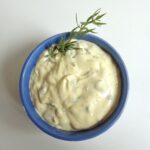 Ok, now on to the sauce. How is French sauce tartare different from the tartar sauce served, say, in the States or in England? Well, for one thing it isn’t sweet. For another it uses capers and can dispense with pickles or pickle relish altogether. This produces a more sophisticated flavor, in my view.
Ok, now on to the sauce. How is French sauce tartare different from the tartar sauce served, say, in the States or in England? Well, for one thing it isn’t sweet. For another it uses capers and can dispense with pickles or pickle relish altogether. This produces a more sophisticated flavor, in my view. A savory tart made with pears and Roquefort cheese can be a lovely start to a meal, and with pears now in season this is a perfect time to try it. The tart is best if you make the crust yourself, in this case a pâte brisée — a tender, savory crust. This may be done a day ahead of time, after which preparation is remarkably quick. I had my tart in the oven 15 minutes after getting home with the pears, and 40 minutes later it was ready.
A savory tart made with pears and Roquefort cheese can be a lovely start to a meal, and with pears now in season this is a perfect time to try it. The tart is best if you make the crust yourself, in this case a pâte brisée — a tender, savory crust. This may be done a day ahead of time, after which preparation is remarkably quick. I had my tart in the oven 15 minutes after getting home with the pears, and 40 minutes later it was ready. I first discovered fig jam many summers ago when I spent a few weeks at a country house in the Cévennes region of southern France. The place was idyllic, lush with fruit both cultivated and wild. We picked the figs straight from the tree. Making the jam was easy, as no pitting of the fruit is involved. And, as I learned, fig jam is heavenly. It manages to capture the musty, lusty fragrance of fresh figs — which happen to be in season right now.
I first discovered fig jam many summers ago when I spent a few weeks at a country house in the Cévennes region of southern France. The place was idyllic, lush with fruit both cultivated and wild. We picked the figs straight from the tree. Making the jam was easy, as no pitting of the fruit is involved. And, as I learned, fig jam is heavenly. It manages to capture the musty, lusty fragrance of fresh figs — which happen to be in season right now.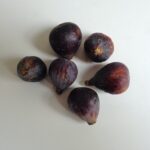 Fig jam is fabulous not only on toast or on buttered baguette, as in the photo, but also on yogurt (which we also made ourselves during that summer in the Cévennes). I usually make this jam with dark purple figs, which lend the jam a beautiful ruby color, but I suspect it would be equally good if made with green figs.
Fig jam is fabulous not only on toast or on buttered baguette, as in the photo, but also on yogurt (which we also made ourselves during that summer in the Cévennes). I usually make this jam with dark purple figs, which lend the jam a beautiful ruby color, but I suspect it would be equally good if made with green figs.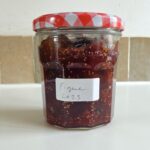 Fig jam didn’t exist in Wisconsin to my knowledge when I was a kid growing up. Nor did fresh figs. The only figs I tasted during childhood were the dried variety that came in Christmas fruit baskets sent by elderly relatives once a year. Then came a summer study program in Avignon. Walking to class one day, I smelled a deiicious aroma. I looked around, and there was a fig tree, heavy with fruit. Well, dear readers, that was an ‘aha’ moment for me.
Fig jam didn’t exist in Wisconsin to my knowledge when I was a kid growing up. Nor did fresh figs. The only figs I tasted during childhood were the dried variety that came in Christmas fruit baskets sent by elderly relatives once a year. Then came a summer study program in Avignon. Walking to class one day, I smelled a deiicious aroma. I looked around, and there was a fig tree, heavy with fruit. Well, dear readers, that was an ‘aha’ moment for me.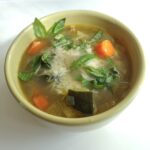 You don’t need to live along the French-Italian Mediterranean rim to enjoy a summer vegetable soup topped with parmesan and fresh basil. This version omits the beans and pasta but is otherwise rather similar to both Italy’s minestrone and Provence’s soupe au pistou. Oh, and did I mention that it also leaves out the tomatoes? It’s an improvisation I came up with one recent sultry day using the ingredients I had on hand in my Paris kitchen.
You don’t need to live along the French-Italian Mediterranean rim to enjoy a summer vegetable soup topped with parmesan and fresh basil. This version omits the beans and pasta but is otherwise rather similar to both Italy’s minestrone and Provence’s soupe au pistou. Oh, and did I mention that it also leaves out the tomatoes? It’s an improvisation I came up with one recent sultry day using the ingredients I had on hand in my Paris kitchen. A bowl of sliced peaches poached in rosé wine with rosemary makes a light and refreshing dessert for hot summer evenings. You can serve the peaches on their own, as I prefer, or take a page from my daughter’s book and serve them over a luxuriously rich burrata. The recipe is simple — the peaches are slipped out of their skins, sliced and poached in a syrup flavored with the rosé and rosemary. A dash of freshly ground black pepper adds bite.
A bowl of sliced peaches poached in rosé wine with rosemary makes a light and refreshing dessert for hot summer evenings. You can serve the peaches on their own, as I prefer, or take a page from my daughter’s book and serve them over a luxuriously rich burrata. The recipe is simple — the peaches are slipped out of their skins, sliced and poached in a syrup flavored with the rosé and rosemary. A dash of freshly ground black pepper adds bite.

